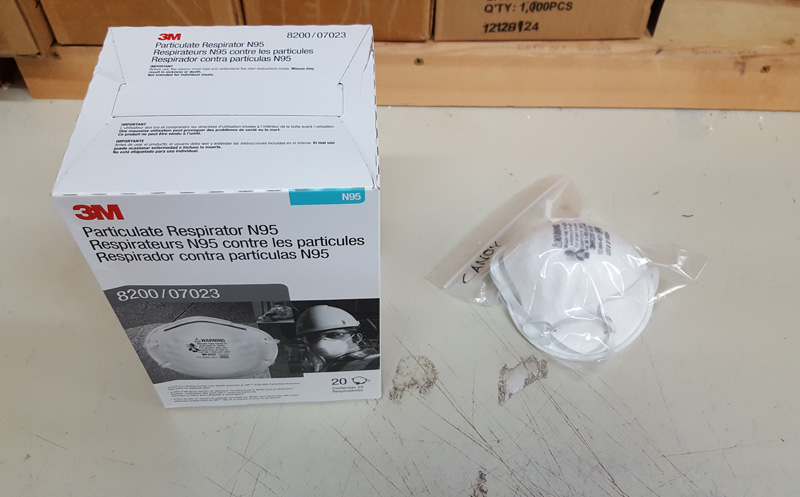Mixing up grout and thinset require that mosaic artists wear dust masks on an occasional basis.
I wear an N95 particulate mask, which is the same one I wear for sawing wood with power tools and many other shop and studio tasks that involve non-oily dust. An N-95 captures 95% of the particles of a certain diameter. Controlling the amount of dust you create is also essential for minimizing exposure, but that would be true even if the masks were rated 100%. No mask can protect you once you take it off.

If It’s Done, Can It
The vacuum-and-bag method below is how I store and reuse dust masks used occasionally for lighter duties.
Of course you might not want to try to do this with a mask you wore on a twelve-hour shift in hot sweaty weather or if the amount of dust you were in was so extreme it affected visibility.
The mask should be disposed if it is saturated with dust or body salts or if it is mechanically worn out (torn, worn thin, creased severely).
Vacuum And Store In A Plastic Bag
Vacuum your mask (without damaging it or feeding it to the pig) and store it in a plastic bag.
The Important Tip
The important tip is how to vacuum it without ruining it or sucking it up in the vacuum. Remember, the pig will snatch up and eat anything, especially if you taunt him with a snack right in front of his suck hole, and his innards were made for contaminating dust masks. Always make sure the elastic band of the mask is twisted around your wrist.
You can also destroy your mask in a less obvious way.
You could create invisible rips and pinhole tears in the mask if you let the vacuum hose get stuck on it. Letting the hose get stuck on the mask also increases the risk of it getting sucked up.
Use brush fitting not bare nozzle. This helps prevent the mask from sealing or sticking to the hose.
Vacuum The Outside First
You also don’t want to suck dirt into the cup of the mask or deeper into the fibers of the mask. Vacuum the outside of the mask first. Then vacuum inside.
Don’t Make A Dust Inhalation Device
A dirty mask is a dust inhalation device, even if all the dust is on the outside of the mask. The act of handing it and putting it on can be enough to clog your sinuses if the mask is dirty enough.
This includes dust from storage as much as it does from previous wearings.
Keep your mask in a plastic bag to prevent dust from settling on it. The plastic bag can be a reused bag (shopping, bread, ziplock).
Don’t Swap Germs Until The Studio Christmas Party
Label bags with a black permanent marker to avoid exchanging germs with coworkers. I’ve found that some people are blind to most forms of labels on personal safety equipment. Capitalized initials in block letters seem to be the most effective, but razor wire probably wouldn’t stop some people from wearing your stuff.

Leave a Reply